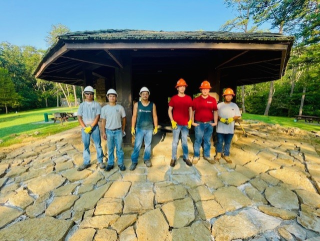Job Corps masonry students help restore Goose Bay Shelter

ILLINOIS — Cass and Mingo Job Corps civilian conservation centers masonry students, led by HistoriCorps professionals, completed critical stone restoration work on the Goose Bay Shelter at Shawnee National Forest. The masons removed and reinstalled the flagstone masonry surrounding the shelter and rehabilitated the exterior stone steps. Working on the project allowed the young masons to refine skills such as mixing mortar, designing layout, leveling stones and tuckpointing. Located on the Lake Glendale recreation area, the Goose Ban shelter restoration efforts will protect the structure from further deterioration and pave the way for future improvements.
Over the years, HistoriCorps has fine-tuned its collaborative process with Job Corps CCCs and national forests to restore underused historic buildings and convert them into heritage tourism destinations. Funded by the Forest Service, with project design and technical assistance provided by HistoriCorps and skilled labor furnished by Job Corps students, these partnerships have been providing opportunities for young people to learn valuable trade skills while supporting efforts to rebuild and maintain the agency’s recreation infrastructure.
Community colleges often offer class credits toward a Historic Preservation Training Certificate to participating Job Corps students. The combined activities of construction trade training, community college course work and real-world experience provide Job Corps students with the skills and credentials that put them on a path to a potential career in historic preservation.
The Civilian Conservation Corps completed the initial development of the Lake Glendale Recreation Area in the 1930s. Most of the structures constructed by the Corps in the 1930s embodies the distinctive characteristics of a type of construction generally known as rustic public architecture. These facilities typically are simple, inexpensive and constructed in a manner that allows them to blend with their rural landscape settings. The Goose Bay Shelter embodies the distinctive characteristics of this type of public architecture.

All CCC students are required to complete work-based learning assignments to earn their trade certification. This real-world learning experience helps prepare them to be successful in a professional work environment filled with diverse personalities, something the students appreciate.
“Working on the Goose Bay Shelter gave Cass Job Corps students the chance to contribute to the preservation of history while building their masonry skills,” said Job Corps liaison specialist Venorris Webb-Delesline.
One of the challenges of restoring historic stonework is matching the type, size, color and texture of existing mortar and stones while also matching up surrounding mortar joints. It is not a process that can be rushed, and the work challenged the young masons’ technical skills in a good way.
“It was great to apply the Job Corps training that I have received on the job site,” said Mingo student Dakota Hamilton. “I learned how to work with people outside of Job Corps, seeing how our differences made the project unique,” echoed Mingo student Dominic Baker.
Job Corps students earned $200 per day working on Goose Bay, earnings that are used to ease their transition to independent living. In addition to learning hands-on preservation skills, students had the opportunity to travel; for one Cass student, it was his first time outside the state of Arkansas.
The collaborative strategy between the Job Corps, HistoriCorps and the Shawnee National Forest on this project helped complete essential campground restoration work in a way that trains a diverse workforce while improving the quality of visitors’ experience. This level of collaboration also exemplifies how underused historic buildings can support efforts to rebuild and maintain the agency’s recreation infrastructure.

